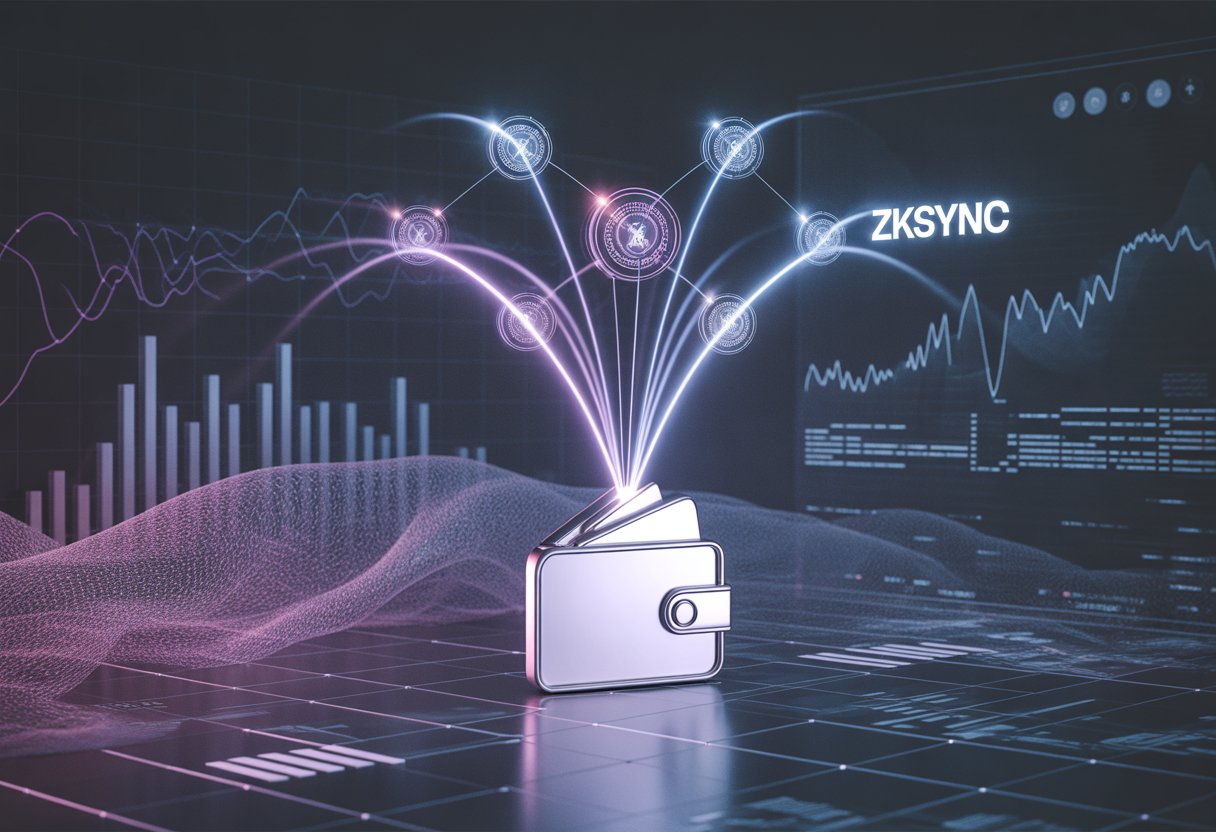
ZKsync is making waves in the crypto world with its upcoming airdrop, distributing 17.5% of its total token supply (3.675 billion ZK tokens) to eligible users. The airdrop targets 695,232 wallets that have engaged with the ZKsync ecosystem, including both ZKsync Era and ZKsync Lite platforms.

Today’s Airdrop Checker Event: Step-by-Step Claim
🌐 Step 1: Visit the Official Airdrop Reward Page.
Dive into the action by heading to the official airdrop page, where all live events are waiting for you. Log into your account by connecting your wallet from any MOBILE/DESKTOP DEVICE.
📱 Step 2: Use Your Mobile Wallet or Desktop
Eligibility checks are mobile or desktop! Grab your smartphone and ensure you’re using a wallet to participate.
💎 Step 3: Meet The Eligibility Criteria
Make sure your wallet isn’t empty or brand new—only active wallets qualify. If one doesn’t work, don’t worry! Try again with another wallet to secure your rewards. You can claim many rewards from multiple wallets, so try to use multiple wallets to increase your chance to claim.
💰 Step 4: Withdraw The Tokens
After signing the approval from your wallet, wait 5 to 10 minutes, and then congratulations! You will see a token claim in your wallet. You can easily exchange your tokens from SushiSwap, PancakeSwap, and many more.
To qualify for the ZKsync airdrop, users need to have transacted on ZKsync Era or ZKsync Lite and meet specific eligibility criteria set by the project. This usage-based distribution approach rewards early adopters and active participants in the ZKsync ecosystem, which focuses on high-performance, verifiable rollups and validiums within its elastic network architecture.
The recent reveal of the airdrop checker has generated significant attention, though not without controversy. Some concerns have emerged regarding potential Sybil attacks (multiple wallets controlled by single entities) and disputed eligibility cases. Users interested in participating can connect their wallets through the official ZKsync Bridge website to check eligibility and claim tokens.
Overview of the zkSync Airdrop

The zkSync airdrop represents a significant token distribution event in the Ethereum ecosystem, with 17.5% of the total ZK token supply (3.675 billion tokens) allocated to eligible participants. This distribution aims to reward early adopters and active users of the zkSync network.
Purpose of the Airdrop
The zkSync airdrop serves multiple strategic objectives within the broader zkSync ecosystem. First, it rewards early adopters who took the risk of using the platform before token launch. This approach recognizes the value of early community support.
Second, the airdrop helps distribute governance rights widely across the user base. By placing tokens in many hands, it supports decentralization goals critical to blockchain projects.
Third, the distribution stimulates ecosystem activity by incentivizing users to engage with zkSync protocols. The airdrop creates momentum for the platform by turning users into stakeholders.
Finally, the allocation approach uses a combination of usage metrics and engagement factors to ensure fair distribution, preventing concentration of tokens among a few large holders.
zkSync and Matter Labs
zkSync is an Ethereum Layer 2 scaling solution developed by Matter Labs. The platform uses zero-knowledge proofs to increase transaction throughput while maintaining Ethereum’s security guarantees.
Matter Labs created zkSync to address Ethereum’s scalability challenges. Their technology enables faster and cheaper transactions compared to the Ethereum base layer, without sacrificing security or decentralization.
The zkSync ecosystem consists of two main components:
- zkSync Lite: The first iteration focusing on transfers and swaps
- zkSync Era: A more advanced implementation supporting smart contracts
The ZK token represents a critical evolution in the zkSync roadmap, transitioning from a purely technical solution to a token-powered ecosystem. Matter Labs designed the token economy to align incentives among developers, users, and validators within the network.
Eligibility Criteria
The zkSync airdrop eligibility follows a multi-layered approach to reward genuine users. A total of 695,232 wallets qualified for the distribution based on specific criteria.
Basic eligibility required users to have transacted on either zkSync Era or zkSync Lite. Simple interactions like transfers, swaps, or smart contract interactions were considered qualifying activities.
The allocation process incorporated four key elements:
- Initial eligibility screening based on network activity
- Token allocation determined by usage patterns
- Multipliers applied for various types of engagement
- Sybil detection to identify and filter fake accounts
The airdrop particularly valued consistent, meaningful engagement over simple one-time interactions. Users who demonstrated regular activity on the platform received higher allocations than those who only performed minimal transactions to qualify.
Airdrop Distribution and Token Mechanics

The ZKsync airdrop employs a carefully designed distribution system with specific technical mechanisms to ensure fairness and security. The token allocation process includes several verification layers and community-focused governance features.
Token Distribution Process
The ZKsync Foundation allocated 19.9% of the total ZK token supply for ecosystem incentives, which includes the airdrop to community members. The distribution followed four main steps: eligibility verification, allocation calculation, multiplier application, and Sybil detection.
Eligibility was determined based on user activity within the ZKsync ecosystem. Users who interacted with the protocol before a specific snapshot date qualified for potential rewards.
The allocation formula considered factors such as transaction volume, frequency of use, and length of engagement with the platform. This approach rewarded loyal users who showed consistent support for the ecosystem.
Multipliers boosted rewards for users who participated in specific activities, such as providing liquidity or testing new features. These multipliers increased the base allocation amount, rewarding deeper ecosystem participation.
The final step involved Sybil detection to prevent users from creating multiple accounts to claim extra tokens. This system helped maintain fairness in the distribution process.
Airdrop Distribution Contracts
ZKsync implemented specialized smart contracts to handle the token distribution process securely and transparently. The main contract managed the verification of eligible addresses and disbursement of tokens.
The distribution contract contained several key functions:
- claimTokens() – Allows eligible users to claim their allocated tokens
- verifyProof() – Validates user eligibility through merkle proofs
- transferTokens() – Transfers the correct amount to verified addresses
These contracts include safety mechanisms like time locks and maximum claim limits to prevent exploitation. All contract code underwent multiple security audits before deployment to ensure funds remained secure.
The claims process was designed to minimize gas fees on Ethereum by leveraging ZKsync’s Layer 2 technology. This helped ensure that even users with smaller allocations could claim their tokens without excessive transaction costs.
Unclaimed Tokens and sweepUnclaimed() Function
The airdrop includes a time-limited claim window for eligible participants. After this period expires, unclaimed tokens don’t simply disappear – they’re handled by the sweepUnclaimed() function within the distribution contract.
This function:
- Identifies tokens not claimed during the official window
- Transfers these tokens to a designated treasury wallet
- Makes them available for future ecosystem development
The unclaimed tokens typically return to the ecosystem development fund for future initiatives. This ensures all allocated tokens serve the ecosystem’s growth even if original recipients don’t claim them.
The protocol designers implemented this mechanism to prevent tokens from being permanently locked and unusable. This approach maintains token circulation and utility within the ecosystem.
Community Governance and the ZK Token
The ZK token serves as the governance token for the ZKsync ecosystem, giving holders voting rights on important protocol decisions. Token holders can create and vote on improvement proposals that shape the platform’s future.
Governance power is proportional to token holdings, with mechanisms to prevent large holders from dominating decisions. The system includes features like:
- Proposal submission thresholds requiring minimum token holdings
- Voting periods lasting multiple days to ensure broad participation
- Delegation options allowing holders to assign voting power to trusted community members
The foundation implemented a gradual transition to full community governance. Initially, the foundation maintained certain veto powers to protect against harmful proposals while the governance system matured.
Users can participate in governance through the official ZKsync portal. The process is designed to be accessible even to those with limited technical knowledge, encouraging broader community involvement in the ecosystem’s development.
Security Incidents and Responses

ZKsync experienced a major security breach in April 2025 when a compromised admin key led to the theft of 111 million tokens valued at approximately $5 million. The incident highlighted critical vulnerabilities in the airdrop system, though swift action from the security team ultimately resulted in the recovery of most stolen funds.
Incident Report and Investigation
On April 13, 2025, ZKsync detected unauthorized activity on their network. An admin account had been compromised, allowing the attacker to mint remaining unclaimed tokens from the ZK token Merkle distributors used for the airdrop. The security team launched an immediate investigation.
By April 15, the full scope became clear: approximately 111 million ZK tokens valued at around $5 million had been stolen. The security breach specifically targeted funds stored in the project’s airdrop smart contracts.
The investigation revealed that the hacker exploited a vulnerability in the airdrop contract. This allowed them to mint tokens that should have remained locked in the distribution system.
Vulnerabilities and the Compromised Key
The primary vulnerability stemmed from inadequate protection of an administrative key with privileged access to the airdrop mechanism. This compromised admin key gave the attacker control over the token minting function without triggering standard security alerts.
The exploit specifically targeted the Merkle distributors, a component designed to efficiently manage token airdrops. Without proper access controls and monitoring, the system allowed the unauthorized minting operation to proceed.
This incident highlighted common weaknesses in airdrop security:
- Insufficient key management protocols
- Inadequate monitoring of admin-level actions
- Vulnerabilities in smart contract permissions
The attack created significant market volatility as traders reacted to the sudden increase in token supply and security concerns.
Security Measures and Team Response
The ZKsync security team responded quickly by tracking the stolen funds across blockchain addresses. They published an incident report detailing the breach while working to mitigate further damage and stabilize token price.
In a surprising turn, the hacker agreed to return nearly 90% of the stolen tokens after accepting a 10% bounty (approximately $500,000) as a reward for identifying the vulnerability. By June 2025, almost $5 million worth of tokens had been recovered and returned to the protocol.
Following the incident, ZKsync implemented several enhanced security measures:
- Multi-signature requirements for administrative actions
- Advanced monitoring systems for token minting events
- Regular third-party security audits
- Improved key management practices
User funds outside the airdrop contracts remained unaffected throughout the incident, helping maintain community trust despite the breach.
Leave a Reply